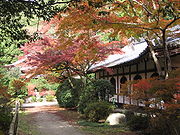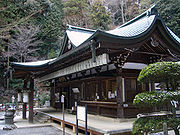
Daigo-ji
Encyclopedia

Shingon Buddhism
is one of the mainstream major schools of Japanese Buddhism and one of the few surviving Esoteric Buddhist lineages that started in the 3rd to 4th century CE that originally spread from India to China through traveling monks such as Vajrabodhi and Amoghavajra...
temple
Temple
A temple is a structure reserved for religious or spiritual activities, such as prayer and sacrifice, or analogous rites. A templum constituted a sacred precinct as defined by a priest, or augur. It has the same root as the word "template," a plan in preparation of the building that was marked out...
in Fushimi-ku
Fushimi-ku, Kyoto
is one of the eleven wards in the city of Kyoto, in Kyoto Prefecture, Japan. Famous places in Fushimi include the Fushimi Inari Shrine, with thousands of torii lining the paths up and down a mountain; Fushimi Castle, originally built by Toyotomi Hideyoshi, with its rebuilt towers and gold-lined...
, Kyoto
Kyoto
is a city in the central part of the island of Honshū, Japan. It has a population close to 1.5 million. Formerly the imperial capital of Japan, it is now the capital of Kyoto Prefecture, as well as a major part of the Osaka-Kobe-Kyoto metropolitan area.-History:...
, Japan
Japan
Japan is an island nation in East Asia. Located in the Pacific Ocean, it lies to the east of the Sea of Japan, China, North Korea, South Korea and Russia, stretching from the Sea of Okhotsk in the north to the East China Sea and Taiwan in the south...
. Its main devotion (honzon) is Yakushi
Bhaisajyaguru
Bhaiṣajyaguru , formally Bhaiṣajyaguruvaidūryaprabharāja , is the buddha of healing and medicine in Mahāyāna Buddhism. Commonly referred to as the "Medicine Buddha", he is described as a doctor who cures suffering using the medicine of his teachings.-Origin:...
. Daigo, literally "ghee
Ghee
Ghee is a class of clarified butter that originated in South Asia and is commonly used in South Asian cuisine....
," is used figuratively to mean "crème de la crème" and is a metaphor of the most profound part of Buddhist thoughts.
History
Daigo-ji was founded in the early Heian periodHeian period
The is the last division of classical Japanese history, running from 794 to 1185. The period is named after the capital city of Heian-kyō, or modern Kyōto. It is the period in Japanese history when Buddhism, Taoism and other Chinese influences were at their height...
. In 874, Rigen-daishi (Shōbō) founded the temple.
After having fallen ill and abdicated in 930
930
Year 930 was a common year starting on Friday of the Julian calendar.- Europe :* With the establishment of the Althing, now one of the world's oldest parliaments, the Icelandic Commonwealth is founded....
, Emperor Daigo
Emperor Daigo
was the 60th emperor of Japan, according to the traditional order of succession.Daigo's reign spanned the years from 897 through 930. He is named after his place of burial.-Traditional narrative:...
entered Buddhist priesthood at this temple. As a monk, he took the Buddhist name Hō-kongō; and shortly thereafter, died at the age of 46. He was buried in the temple, which is why his posthumous name was Daigo.
National treasures
Several structures, including the kondō and the five-story pagoda, are National Treasures of JapanNational treasures of Japan
National Treasures are the most precious of Japan's Tangible Cultural Properties, as determined and designated by the Agency for Cultural Affairs...
. The temple possesses 18 specifically designated national treasures, including the buildings and other works as well; and the temple holds several dozen important cultural assets. Wall paintings at the temple were the subject of academic research which earned the Imperial Prize of the Japan Academy
Imperial Prize of the Japan Academy
The was a prestigious honor conferred by the Imperial Academy from 1911 through 1945. The award was presented to non-members in recognition of their academic theses, books, and achievements....
in 1960.
As part of the "Historic Monuments of Ancient Kyoto
Historic Monuments of Ancient Kyoto
The UNESCO World Heritage Site Historic Monuments of Ancient Kyoto encompasses 17 locations in Japan. The locations are in three cities: Kyoto and Uji in Kyoto Prefecture; and Ōtsu in Shiga Prefecture. Of the monuments, 13 are Buddhist temples; 3 are Shinto shrines; and one is a castle...
," it is included a World Heritage Site
World Heritage Site
A UNESCO World Heritage Site is a place that is listed by the UNESCO as of special cultural or physical significance...
.
The five-story pagoda
Pagoda
A pagoda is the general term in the English language for a tiered tower with multiple eaves common in Nepal, India, China, Japan, Korea, Vietnam and other parts of Asia. Some pagodas are used as Taoist houses of worship. Most pagodas were built to have a religious function, most commonly Buddhist,...
at Daigoji temple was built in 951 and is the oldest building in Kyoto
Kyoto
is a city in the central part of the island of Honshū, Japan. It has a population close to 1.5 million. Formerly the imperial capital of Japan, it is now the capital of Kyoto Prefecture, as well as a major part of the Osaka-Kobe-Kyoto metropolitan area.-History:...
. It was one of few buildings to survive the Onin War
Onin War
The ' was a civil war that lasted 10 years during the Muromachi period in Japan. A dispute between Hosokawa Katsumoto and Yamana Sōzen escalated into a nationwide war involving the Ashikaga shogunate and a number of daimyo in many regions of Japan....
in the 15th century.
Garden

Toyotomi Hideyoshi
was a daimyo warrior, general and politician of the Sengoku period. He unified the political factions of Japan. He succeeded his former liege lord, Oda Nobunaga, and brought an end to the Sengoku period. The period of his rule is often called the Momoyama period, named after Hideyoshi's castle...
held a famous cherry-blossom
Sakura
A cherry blossom is the flower of any of several trees of genus Prunus, particularly the Japanese Cherry, Prunus serrulata, which is sometimes called sakura after the Japanese . Many of the varieties that have been cultivated for ornamental use do not produce fruit...
-viewing party in 1598 at the Sambō-in sub-temple.
The bright colors of maple leaves attract tourists and others in the Autumn season. Emperor Suzaku
Emperor Suzaku
was the 61st emperor of Japan, according to the traditional order of succession.Suzaku's reign spanned the years from 930 through 946.-Traditional narrative:...
's mausoleum, known as Daigo no misasagi, is located near Daigo-ji.
Events

Kansai Kannon Pilgrimage
The is a pilgrimage of thirty-three Buddhist temples throughout the Kansai region of Japan, similar to the Shikoku Pilgrimage. In addition to the official thirty-three temples, there are an additional three known as...
. The structure dated from 1968.
See also
- List of Buddhist temples in Kyoto
- List of National Treasures of Japan (temples)
- List of National Treasures of Japan (ancient documents)
- List of National Treasures of Japan (paintings)
- List of National Treasures of Japan (sculptures)
- List of National Treasures of Japan (writings)
- For an explanation of terms concerning Japanese Buddhism, Japanese Buddhist art, and Japanese Buddhist temple architecture, see the Glossary of Japanese BuddhismGlossary of Japanese BuddhismThis is the glossary of Japanese Buddhism, including major terms the casual reader might find useful in understanding articles on the subject. Words followed by an asterisk are illustrated by an image in one of the photo galleries...
.

